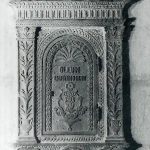The furnishings of the Propositura of Laterina consist of numerous liturgical items and sacred vestments, dating from the mid-17th century to the 20th century. The most significant objects are those donated by the church’s rectors, who came from noble families. The parish priests and provosts who have succeeded one another over time have left important traces from a historical and artistic perspective, starting with the tabernacle for the holy oils commissioned by the parish priest Bracciolini, a member of the renowned family from Terranuova. The tabernacle, made of stone with a wooden door, is located in the left semi-pillar of the presbytery and bears the emblem of the Valdarnese family. The decorative and architectural elements confirm a dating to the late 15th century.
Other important commissions came from the Busatti family, including a paliotto in scagliola, dated 1697, and a monstrance with a figured stem, dated 1701. This type was very popular in Tuscany, particularly in the second half of the 17th century. Characteristic of the Foggia style is the triangular base with trapezoidal faces, often decorated with acanthus leaves, vegetal garlands, shells, and volutes. After Parish Priest Busatti, Don Guillichini took over in 1707. His family was originally from Città di Castello.
He commissioned, among various furnishings, a chasuble in green brocaded damask, featuring a floral decoration in small clusters, which can be dated to the period between the late 17th century and the early 18th century. In 1758, Don Ippolito Rossi became the provost of Laterina, coming from Piantravigne. He was a man of ambitious and determined character, and an exceptional patron of the Laterina furnishings. He primarily purchased items from the workshops in Florence, as evidenced by some furnishings dated 1761 and decorated with his family crest, where the Florentine origin of the stamp is confirmed. Rossi continued to commission furnishings for the Laterina church until his death in 1806.
Don Ippolito also had several vestments made, all marked with his family crest, including a pink chasuble and a white vestment, both in launched taffeta and brocade, featuring a decoration known as “meander,” typical of the 18th century. This style is characterized by floral and vegetal elements arranged in a geometric composition, with zigzag vertical lines. The provosts who followed Rossi, namely Don Francesco Guerri and Don Luigi Luciani, focused primarily on restoring the church building. Luciani likely commissioned a series of “carteglorie” (decorative cloths) from the Florentine workshop of the Gherardi family on the Ponte Vecchio.
The reliquary of Saints Ippolito and Cassiano, dating to 1860, is notable for its unique shape and the blending of various materials and styles, with many references to the French style, commonly referred to as ‘Empire’.
Manola Rosadini







